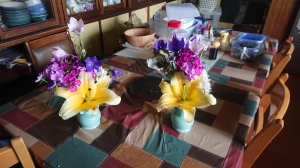Today is Juneteenth, America’s newest federal holiday. (NPR) From what I’ve read, the day is not so much about freedom, as it is about the long, terrible road that enslaved people had to walk to get to freedom, and the struggle to stay in a state of freedom.
“We hold these truths to be self-evident, that all men are created equal, that they are endowed by their Creator with certain inalienable rights, that among these are Life, Liberty and the pursuit of Happiness.” Memorable words that helped found a nation, written by an enslaver.
I ran across this excerpt by Clint Smith on The Paris Review Twitter account this morning, and if you haven’t read it, you should. Beautiful writing, and it explains what exactly happened on Juneteenth, and illustrates how it can resonate with Black Americans today. Here’s his tweet. Clint’s excerpt from How the Word is Passed: A Reckoning with the History of Slavery Across America is set on the Galveston, TX, plantation where enslaved people learned of their freedom in 1865.
Greedy people who valued pretty dresses and a big house over the lives of fellow human beings stained US history with this atrocity, and too many people just went along with it and let it happen. Lest we forget . . . lest we let it happen again. Let’s remember Juneteenth.
PART TWO:
The contemporary white views in Galveston were pretty outrageous. Flake’s Weekly Bulletin of Galveston (Wednesday morning, July 19, 1865) complained on the front page of being accused of sucking up to the authorities in charge. It’s clear, though, that their sympathies are with the white people and the old system, although they take issue with the rebel leaders who they accuse of leading them into the mess of war and privation.
On page 2 (top of sixth column) of the newspaper, General Granger (who read General Order No. 3 to the enslaved people) is discussed. The paper is concerned that the cotton and corn is good, and the grapes are coming in . . . but if the planters stand firm and don’t hire people from other plantations, the formerly enslaved will have no choice but to work or starve.
“A few months delay would have saved some millions of dollars to the planters in the incoming crops, by securing the promising harvest; and some thousands of lives that the sudden change exposes to all the ills of the hot and sickly season.” Yeah, right. If only General Granger had delayed a few more months (never mind the years that had already passed since the enslaved were freed), I’m sure the planters would have sent the healthy Black people off with a nice percentage of the millions, and wished them well. (No, I do not think that for one moment.)
The parallels to the recent Jan. 6 sedition are striking. The paper cast legal doubt on the proclamation freeing the enslaved. They blame “false teachings of corrupt leaders” for people participating in the secession from the States. The heart (by which I think they mean the paper’s editorial staff and most white Galvestonians) “weeps over the stern necessity that dictates their (the warmongers) humiliation.” Oh, boo-effing-hoo.
But I suppose the editors of the newspaper had to tread that line between pleasing the federal authorities, and living with their neighbors. I’m not excusing them. It’s important to read these expressions of white supremacy. It made me realize just how much the arguments white supremacy puts forth really haven’t changed in all those years.
So when I say we shouldn’t forget, I mean not only what was done, but who was doing it and how. Juneteenth is a day to remember.
(I also recommend historian Henry Louis Gates, Jr.’s excellent article, “What is Juneteenth?” for extra perspective.)




 Settings play a huge role in my demon novels. All of the books spend some time in my take on Hell, which is a cross between the fire-and-brimstone Hell described by the terrifying Baptist preachers of my childhood and the equally terrifying large corporations I worked for during my career as a software engineer, but each of them also has a more mundane setting here Aboveworld.
Settings play a huge role in my demon novels. All of the books spend some time in my take on Hell, which is a cross between the fire-and-brimstone Hell described by the terrifying Baptist preachers of my childhood and the equally terrifying large corporations I worked for during my career as a software engineer, but each of them also has a more mundane setting here Aboveworld.


 Recently, we had a conversation on one of my author loops on applying Six Sigma/Lean Manufacturing techniques to writing. Apparently some guru will soon be teaching a class on using Kanban boards to increase author efficiency.
Recently, we had a conversation on one of my author loops on applying Six Sigma/Lean Manufacturing techniques to writing. Apparently some guru will soon be teaching a class on using Kanban boards to increase author efficiency.
You must be logged in to post a comment.